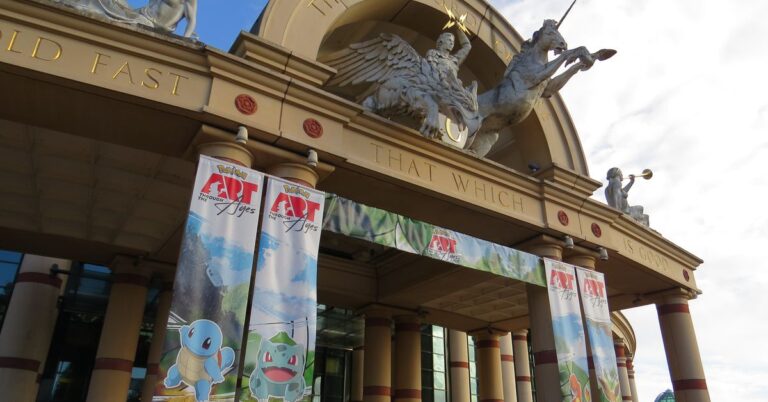
[ad_1]
The giant screen above the stage at The Trafford Centre in Manchester was playing the 17th Pokémon movie, Pokémon the Movie: Kyurem vs. the Sword. Released in 2012, it mostly highlights the unicorn-like Keldeo, which made its way to the franchise in Generation V, or Pokémon Black and White.
I didn’t recognize it. Generation V was part of the era when I had fallen out of keeping up with Pokémon, the middle days between a childhood obsession and adult enjoyment. But it didn’t matter. Keldeo was basically the only pokémon on display that wasn’t part of the original 151. Those were the ones we were tasked with finding, hidden in colorful murals across the mall — because when it comes to nostalgia, nothing can beat Generation I.
Treading the line between nostalgia and innovation has always been a tension that Pokémon has been keen on navigating. But in 2022, it’s more present than ever. February’s Pokémon Legends: Arceus broke the mold with its open world, and now, Pokémon Scarlet and Violet are bringing those changes into the mainline games. And yet, reminiscence over the franchise’s origins seems more present than ever.
In the recent book Monster Kids: How Pokémon Taught a Generation to Catch Them All, author Daniel Dockery investigates the first four years, the peak era of Pokémania. “The fact that it’s a fairly benign story about befriending others and caring for the world that was turned into a cross-market goliath of rampant branding is not lost on me,” he writes. “As with all art, we often must wrestle with and reconcile how it is created and how it is sold.”
I have no idea what the behind-the-scenes branding intention behind The Trafford Centre’s Pokémon: Art Through the Ages exhibition was. There were ads for the anime and the upcoming Scarlet and Violet games, but they were hardly intrusive. All focus was on the original suite of pokémon that hit our screens back in the late 1990s. If the organizers wanted to sell the series, they were doing it based on pure nostalgia.
And the people who were at The Trafford Centre on a breezy Thursday morning in early November surely already knew that Scarlet and Violet were on their way. The mall was busy with shoppers, but at least 1 in 10 was conspicuously clutching the booklet with the checklist and a bunch of activities aimed at kids of maybe five to seven years old. Most of them, like me, were in their 20s.
If the organizers wanted to sell the series, they were doing it based on pure nostalgia
Then again, maybe most of them had fallen out of love at some point and never picked back up with the ever-changing franchise, the way I missed out on Keldeo. I explored with my sister and mother, neither of whom could have told you that Scarlet and Violet are out this month. They’re both avid Pokémon Go players, but other than that, their investment is entirely reliant on the past.
My sister and I got into Pokémon when the anime was airing in the UK. My mother had heard the rumors about this new series being terrible for kids, so she sat down and watched an episode herself to see whether we’d be allowed to participate. It happened to be episode 30, “Dig Those Diglett!,” in which the underground pokémon unionize to stop an environmentally destructive dam from being built. My mother has been an environmentalist since the ‘70s, and she’ll still sing the praises of that episode whenever she gets the chance.
It’s an image that’s both captured and overlooked by Monster Kids. The book does a great job of establishing how well Pokémon drew kids in but casts parents as bemused at best and hostile at worst. That was never the case in our family. Though not available for the Manchester hunt, I remember my father telling me I’d get to call myself a real pokémon master when I could beat him in a battle and, true to his word, designing and printing off a certificate the first time I pulled it off. My mother loves to tell the story of how my sister learned to read using the toy pokédex we were given as a gift one Christmas. I still have a soft spot for Golem because that was the random figurine I got from a pokéball they gave us the same year.
After the anime and the toys, we had a trio of Nintendo 64 games: Pokémon Yellow, Pokémon Stadium, and Pokémon Puzzle League. But like many others, we dropped off after just a few years — before the release of Gold and Silver and Generation II. As Dockery writes, those games were supposed to be the end of Pokémon, and the anime was planned to wrap up around the same time. But financial interests couldn’t let it die. Twenty-five years later, it’s bigger than ever.
Once Scarlet and Violet hit shelves, three new Pokémon entries will have been released in less than a year, with Brilliant Diamond and Shining Pearl last November and Legends: Arceus in February. The plucky, feel-good TV show about nature and collaboration that my mother fell in love with doesn’t really exist beneath the weight of corporate branding. But if there’s one thing I learned running around a shopping center in search of critters to point at and remember, it’s that the Pokémon Company knows how beneficial it is to pretend that it still does.
Arguments about which generation is better aren’t just internet fights; they’re an internal tension that Nintendo struggles to appease as it branches out into open worlds while still keeping Charmander, Squirtle, and Bulbasaur front and center. But leaning on that nostalgia does seem to be working. Like me, many people’s investment in Pokémon has likely waxed and waned with time. But it doesn’t really matter: the renaissance looks backward as much as forward.
[ad_2]